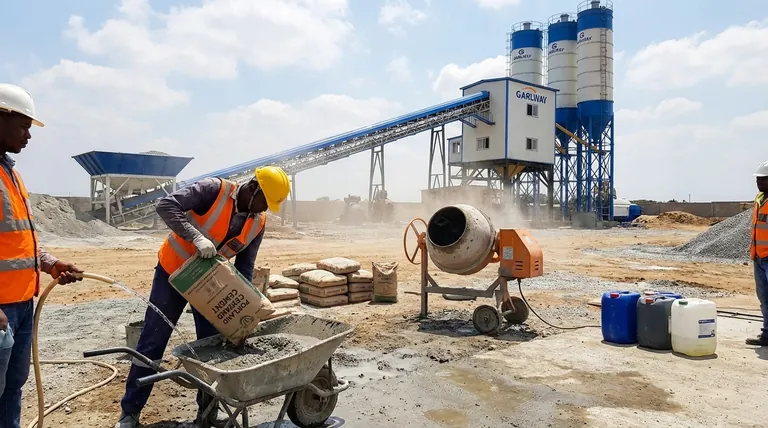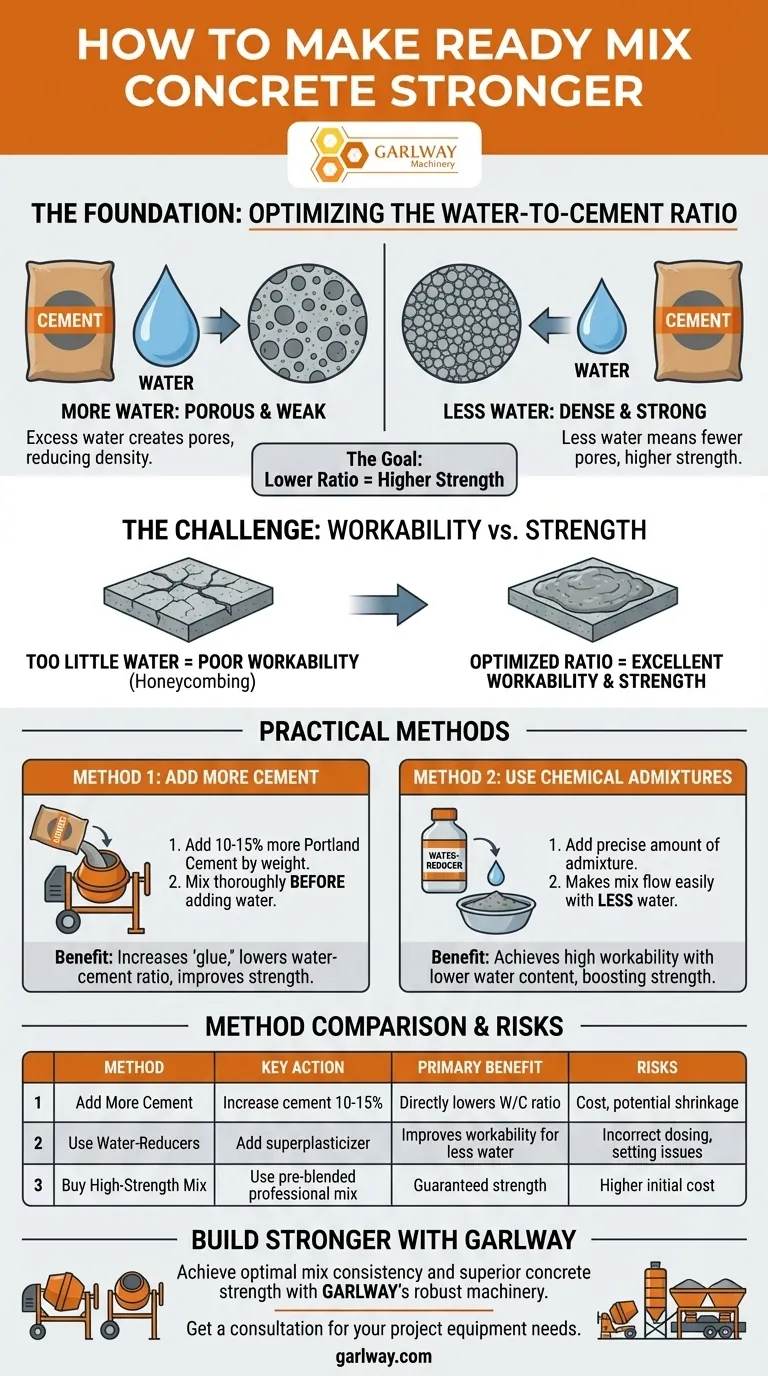To make ready-mix concrete stronger, the most direct method is to increase its cement content by adding more Portland cement to the mix. However, the single most critical factor for concrete strength is achieving a low water-to-cement ratio, which can be accomplished by adding more cement or by using specialized chemical admixtures.
The core principle of concrete strength is not about adding more of any single ingredient, but about optimizing the ratio between cement and water. Less water relative to the amount of cement results in a denser, stronger, and more durable final product.

The Foundation of Concrete Strength: The Water-to-Cement Ratio
The relationship between water, cement, and overall strength is the most important concept to grasp when working with concrete. Think of the cement and water paste as the "glue" that holds the sand and gravel (the aggregates) together.
Why Less Water Equals More Strength
When cement and water are mixed, a chemical reaction called hydration occurs, forming crystals that bind the aggregates. Using more water than is necessary for this reaction creates excess space in the mix.
As the concrete cures and this excess water evaporates, it leaves behind a network of tiny pores and capillaries. This porous structure is the primary source of weakness and permeability in the finished concrete.
A lower water-to-cement ratio means less excess water, fewer pores, and therefore a denser, stronger material.
The Problem with Unworkable Concrete
Simply reducing the amount of water in a standard bag of ready-mix will make the concrete stiff, dry, and extremely difficult to mix, place, and finish properly. This is known as poor workability.
Forcing a dry mix can lead to honeycombing (voids) and poor compaction, which completely negates the benefits of using less water.
Practical Methods for Strengthening Your Mix
To increase strength, you must lower the water-to-cement ratio without sacrificing the workability needed to do the job correctly.
Method 1: Add More Portland Cement
The most straightforward approach for on-site work is to enrich the mix by adding more cement. This alters the water-to-cement ratio in your favor.
By increasing the amount of "glue," you ensure there is enough paste to make the concrete workable while keeping the water-to-cement ratio low. A common practice is to add 10-15% more Portland cement by weight to a standard bag mix.
Crucially, you must mix the dry components thoroughly before adding any water to ensure the extra cement is evenly distributed.
Method 2: Use Chemical Admixtures
The professional solution is to use chemical admixtures, specifically water-reducers or superplasticizers. These chemicals make the concrete mixture flow much more easily.
This allows you to achieve excellent workability with significantly less water, directly leading to a lower water-to-cement ratio and higher strength.
Understanding the Trade-offs and Risks
Modifying a pre-blended mix is not without risk and requires careful consideration.
The Risk of Incorrect Dosing
Admixtures are highly concentrated and require precise measurement, which is difficult to achieve when mixing single bags. Using too much can delay setting times or cause other unintended consequences.
Likewise, adding too much extra cement without adjusting other components can sometimes lead to increased shrinkage and a higher potential for cracking.
What About Hydrated Lime?
While adding hydrated lime is a traditional practice, its primary benefit is improving the workability and plasticity of mortar, not maximizing the compressive strength of modern concrete.
For pure strength gain, focusing on the water-to-cement ratio through cement enrichment or water-reducers is a much more effective strategy.
Making the Right Choice for Your Project
Your approach should be dictated by your project's requirements and your comfort level with modifying the mix.
- If your primary focus is a reliable strength boost: The safest and most direct method is to buy a pre-blended, high-strength concrete mix that is professionally formulated for this purpose.
- If your primary focus is modifying an existing standard mix: Carefully adding 10-15% more Portland cement by weight and mixing thoroughly before adding water is your most practical option.
- If you are attempting a specialized project like a countertop: Researching and precisely measuring a water-reducing admixture may be worthwhile, but you should always create small test batches first.
Ultimately, strengthening concrete is a precise process of controlling the ratio of its core components.
Summary Table:
| Method | Key Action | Primary Benefit |
|---|---|---|
| Add More Cement | Increase Portland cement by 10-15% | Directly lowers water-to-cement ratio |
| Use Water-Reducers | Add superplasticizer admixtures | Improves workability, allowing less water |
| Buy High-Strength Mix | Use pre-blended, high-strength concrete | Guaranteed strength from professional formulation |
Need a reliable, high-strength concrete solution for your construction project?
GARLWAY specializes in providing robust construction machinery and expert support for contractors and construction companies worldwide. Our concrete mixers and batching plants are engineered to help you achieve optimal mix consistency and superior concrete strength on every job.
Let us help you build stronger:
- Get a consultation on the right equipment for your project specifications.
- Ensure mix quality with machinery designed for precision and durability.
Contact our experts today to discuss how GARLWAY can support your success.
Visual Guide

Related Products
- HZS75 Concrete Batching Plant Cement Mixer Price Concrete Mixer Bunnings Mixing Plant
- HZS120 Ready Mix Concrete Batching Plant Commercial Mud Cement Mixer
- HZS180 Ready Mix Concrete Plant for Foundations with Sand and Cement
- HZS35 Small Cement Concrete Mixing Batch Plant
- Ready Mixer Machine for Construction Ready Mix Machinery
People Also Ask
- Can you mix mortar in a cement mixer? Avoid weak joints and project failure.
- Can you mix self leveling concrete in a cement mixer? Avoid Costly Flooring Mistakes
- How much does a batching plant cost? Uncover the True Investment for Your Project
- Do you put water or cement in a cement mixer first? Master the Professional Layering Method
- How do I choose a cement mixer? Find the Perfect Match for Your Project Scale and Power Needs















